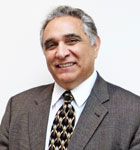
I call my career choice lucky. I found out about engineering my last year of high school because I went to a school that took us to a university career day. I was sitting in the auditorium and I was listening to them talk about engineering and my brain is clicking, “Yes, yes, yes, that is what I want to do.”
I began working at NASA at the time of the first energy crisis. A chemical engineer by training, I interviewed and was hired by NASA directly out of college. During those days NASA was doing a lot of work in energy such as batteries, fuel cells, and wind, in support of different ways to reduce our energy consumption. The targeted improvement of life on earth combined with the power systems for spacecraft and space operations enticed me to accept the position.
I spent my first nearly nine years in research but I wanted to round out my competencies so I took various positions within NASA. I went from research to project management—concentrating on technology experiments in micro-gravity science—to learning how the centers do business. When an executive officer position for the Center director opened, I applied and got it. Many urged me not to take the position because it was seen as more of an administrative position but it provided me an opportunity to see the organization at a higher level. I took my first supervisor job in 2000 and have been the director of engineering, Glenn Research Center, for the last seven years.
One of the best things about my position is that every day is unique. We don’t do something more than once. We are constantly experiencing new things—new programs and new projects. We strive to apply any of the knowledge gained to the community or industry. Our mission is to take technologies that are on the cusp of being proven, and take [them] to the next step. We do the engineering analysis, design, development, and testing to verify the hardware or software can survive the environment if it is put into space. We just passed a systems review and are preparing to deliver a system called Connect—a communications and networking test bed to test new communications protocols. This payload will be put in space and we will be able to reconfigure it from the ground and conduct various tests. Most technology demonstrations go unnoticed but they are what enable the new missions.
NASA has changed dramatically over my 30-plus years with the organization. NASA’s internal environment changed for the best, it is more culturally accepting. But, the thing that has become more challenging is the political environment. We see constant programmatic changes. Fortunately, in recent months, NASA received approval from Congress to move forward on some of the new programs.
I get involved in various organizations because we continue to see very few Hispanic women engineers. It is not significant what I did or do, but it is important that little girls see Hispanic women doing things that are not traditional. You typically make a decision based on what you know. So, it is important to actually let children know there are other opportunities out there and there are people like them that are doing it—putting that face out there so kids consider different careers is critical.

